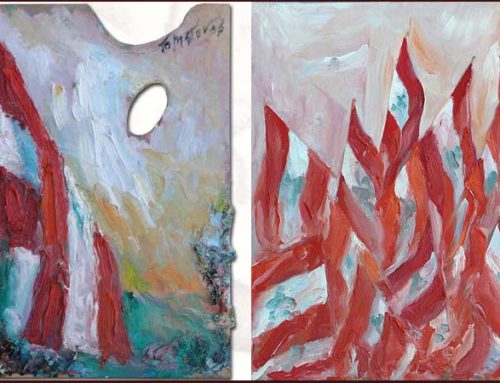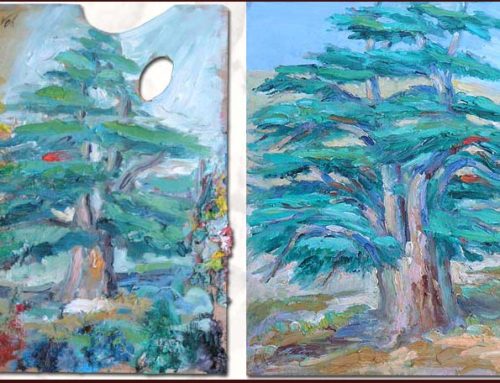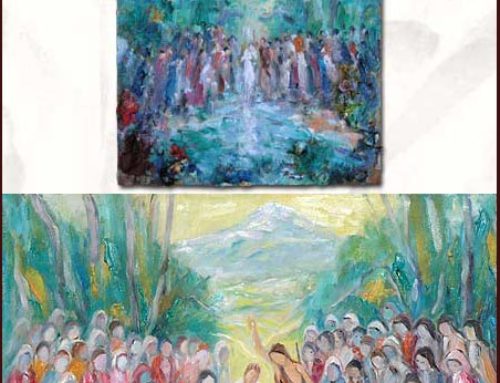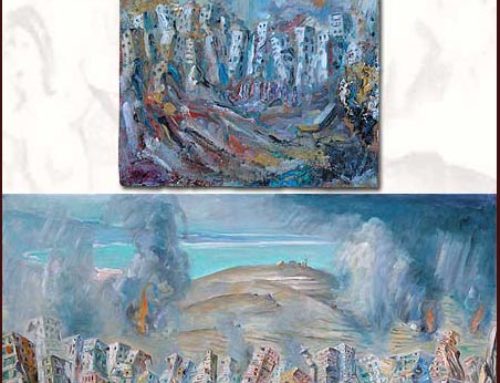Bkerke Esplanade
One evening recently I was at Bkerke for the requiem of a saintly man, bishop of the Maronite rite and what is more a distinguished former Lebanese Maronite apostolic nuncio in the countries of Southern Europe. All the bishops of the rite were there around the Patriarch, and there were hundreds of cars that had brought relatives and friends of the deceased in front of this our little local Vatican, all of whom wished to express their sympathy and listen to the deeply moving funeral chants.
As the inside chapel of the patriarchate was too small to accommodate the crowd, the ceremony took place on the East Esplanade facing the main building. This esplanade arranged as a huge square able to hold either an immense crowd or to act as a vast car park for the vehicles of visiting notables has recently been adapted as a spacious chapel for times when there are ceremonies with an exceptional congregation, as was the case this particular evening.
But what a chapel! A furnace rather, under the glass dome which had trapped the fierce rays of the summer sun all during the day!
The architect, and the clergy who had ordered this oven, were really lacking in imagination. One was soaked by one’s sweat inside despite the whirring of the ventilators which rivaled the liturgical chant and the funeral orations. The sun beat down sending down glare and suffocating heat with its merciless rays. Had this space been conceived only for gatherings during the comparative cool of morning or of night? Was there no other place and no other form of air conditioning suitable for such ceremonies, taking advantage perhaps of the well-wooded slopes of the district? There had been in fact an evident lack of boldness or of common sense. There had been an effort to make up for this shortcoming by additions supposed to be artistic that I, a professional artist, found naives and absolutely detestable.
Standing face to the outside structure and the shade of the entrance wall, I had every disposition to bemoan rather than to pray – in any case in my view the holy person was already well in heaven without need of our intercession. I could not help thinking of the masterpieces with which artists and patrons had enriched other churches and chapels. We were far, where we were, from the spirit of a Pope Julius II or of the Medicis who had raised such splendid monuments. Did our Patriarch and his college of counselors think themselves architects and qualified in the plastic arts and esthetic taste? An assembly formed of anybody and everybody! Did His Beatitude, his General Staff, and his advisors wish to rival the Square of St. Peter’s in Rome or of the Cibeles in Madrid, or of the Concorde or the Opera in Paris?
It seems that they were very self-confident about what they were doing and full of trust in those they had approached. But at least they should have submitted such a project to open competition and referred to persons of both competence and good will. Instead they have produced a masterpiece of ugliness, destroyed an agreeable environment and created something that is both a furnace in summer and a freezer in winter.
Have these authorities not traveled abroad and see the great monuments of the world, from the achievements of the Romans down to those of recent times? Have they not seen the cathedrals, churches, crypts and sanctuaries of France, Spain and Italy, not to mention elsewhere, especially “Val de los Caïdos”, the Valley of the Martyrs, in a mountainous region not unlike Lebanon? Instead we have been given at Bkerke a glorified parking lot in the worst possible taste.
To take just this wall (overhung by three or four high-tension pylons), without form or character, are these two openings and “holes” meant for side-chapels? They are bad enough, but in the middle there is a giant glass semicircular dome of quite exceptional ugliness.
In a country with a climate that is generally quite warm, even hot at times, would it not have been normal to create zones of cool shade instead of a veritable oven?
Is this really a place of prayer, of meditation, of contemplation, of communion with heaven? What conception do those in charge have of sacred art? Is this place a Forum? A theater? A square for public spectacles? What is gained by that cross in the background of raw concrete?
Yes, this is the vulgarity of “Saint Sulpice”, schmaltz. What are these mosaics doing with their representation of the Holy Father John Paul II with His Beatitude? In past times when benefactors to Christianity placed an order with the great masters, they asked to be shown in some small corner of the main work.
Despite their simplicity and lack of splendor and riches, our old churches were agreeable and picturesque, places where one could meet, a book of love uniting God and men. These humble buildings blend with their surroundings. In Europe the cathedrals were veritable universities where people could cultivate and deepen their knowledge thanks to works of art such as sculptures, paintings and stained glass.
Bourges for example differs from Amiens, one celebrating the virtues while the other is messianic. Such cathedrals speak of the coming of the Savior, or they illustrate the Golden Legend or the marvels of creation, and as such are encyclopedias full of information.
Reims is the one national cathedral of France, with its memories of the baptism of Clovis and of the kings who followed him, all the others being Catholic, that is to say universal.
The clergy could teach the faithful great truths, the power of art, Christian thought, and Victor Hugo spoke the truth when he said “The Cathedral is a book in stone for the ignorant.”
Once upon a time our good old priests and monks taught the Catechism under the village oak tree, giving lessons about virtue, holiness, love of the soil, the closeness of family ties. So is it possible that in Lebanon we have no artists gifted for portraying sanctity and religion? As for myself, I who had come to attend the requiem of a friend, I had to pluck up courage to cross the square under a scorching sun to sit in a Turkish bath!
In front of our Patriarchate, another square should have been laid out, following another plan, this holy place being integrated into its true environment. As I criticize this project I also criticize myself. I remember that for several years I was a pupil of His Beatitude in the school of the Brothers, and what an excellent teacher he was.
So should we accuse his advisors who perhaps are not competent in such matters and perhaps ought to have sought the advice of those more qualified, and having the ideas, concepts, forethoughts, studies and vision needed to make this site a centerpiece for the whole Christian East?
I am not one who favors Churches representing power and political interests. I passionately uphold the poor churches of Iraq where our brothers, priests and people, are murdered, martyred, together with their bishop whose throat was cut, and where their sacred buildings are blown up. Yet these faithful resist and retain their belief in God. Can this be called “toleration” on the part of other religions? Is this acceptance of others? What lies! What crimes are committed in the name of God!
The true witnesses of Christ are these persecuted Syriacs, these Orthodox, Catholics, Chaldeans, Copts and others who represent the true Ecclesia, the assembly of the faithful, far from televised parades and ceremonial splendor, luxury and riches. These people have truly sold all their possessions to follow Our Lord. I have intimated that the Church of the Powers-that-Be is not the Church of Christ; so let us render unto Caesar what is Caesar’s and may the sun of the Orient enlighten, guide and illuminate all our dear Lebanese and in particular our clergy.
When the disciples of Christ held back, when they lacked courage and ardor, force and love, it was that apostle of apostles Mary Magdalen who before the Crucified exclaimed, “If all abandon you I am here with you and will not abandon you!”
Joseph Matar
All rights reserved © LebanonArt
Translated from French: K.J.Mortimer







